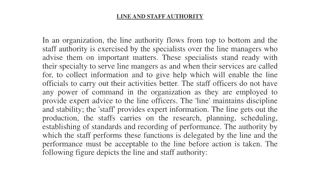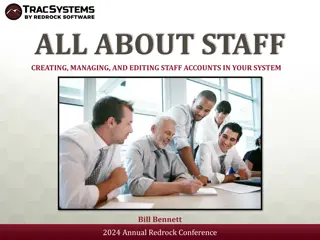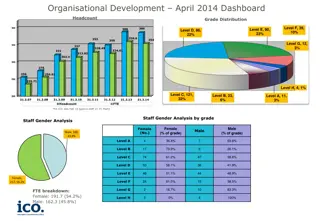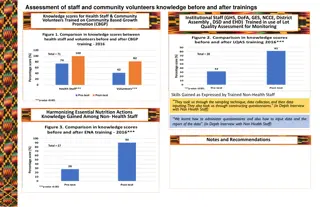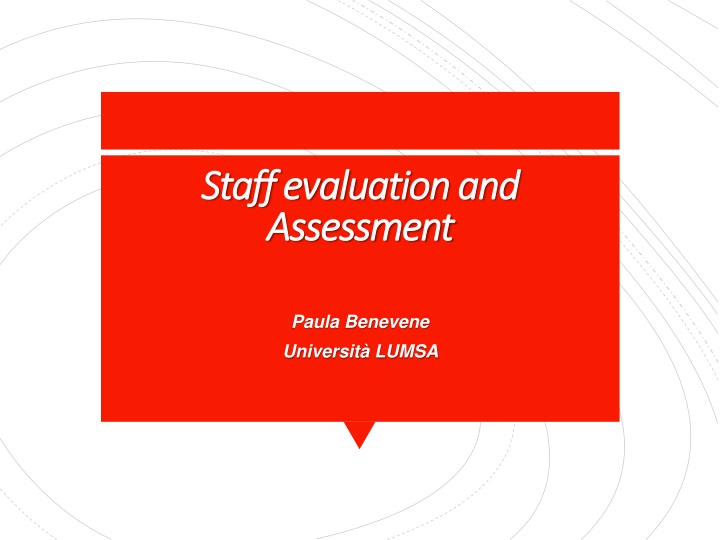
Staff Evaluation and Assessment in Human Resources
Explore the importance of staff evaluation, job positions, performance assessment, and potential evaluation in the organizational context. Learn about job evaluation, role definition, and the skills necessary for job positions.
Download Presentation

Please find below an Image/Link to download the presentation.
The content on the website is provided AS IS for your information and personal use only. It may not be sold, licensed, or shared on other websites without obtaining consent from the author. If you encounter any issues during the download, it is possible that the publisher has removed the file from their server.
You are allowed to download the files provided on this website for personal or commercial use, subject to the condition that they are used lawfully. All files are the property of their respective owners.
The content on the website is provided AS IS for your information and personal use only. It may not be sold, licensed, or shared on other websites without obtaining consent from the author.
E N D
Presentation Transcript
Staff evaluation and Staff evaluation and Assessment Assessment Paula Benevene Universit LUMSA
a) Evaluation of positions (or job evaluation); b) Evaluation of work performance; c) The evaluation of the potential; Staff appraisal includes : Staff appraisal includes : d) The assessment of skills. The evaluation has as an important element: the restitution it is the feedback given to the person who was evaluated
a) The evaluation of the position concerns the assigned to each professional figure, in relation relevance that this role covers within the organization itself; Performance aimed at the past, because it is based on the already provided by the worker. remuneration Staff evaluation to the b) evaluation is contribution Staff appraisal includes : Staff appraisal includes : c) The evaluation of the potential is aimed at the future, namely at what the worker will be able to do, using knowledge already owned by the employee; skills and d) The assessment of skills is aimed at the present;
It is the starting point for evaluating the human resources of an organizational. It accurately identifies and describes the characteristics of each job position within an organization. In particular: Job evaluation Job evaluation The position in the organization chart; Its purposes; Responsibilities people; and coordination of The tasks assigned to the professional figure in question; The activities carried out.
To collect this information usually: We address those who already work in that job position, their superiors and those who are able to provide relevant information in this regard; Job evaluation Job evaluation The organization, relating to that specific job position, is analyzed organizational purposes, objectives to be achieved. documentation present in the to detect methods, its
The job position is different even if connected to the "Whoever holds a job position enriches it with their own content over time and 'interprets' it: this is commonly defined as role ... while the job position emphasizes the structural aspects, the role refers to the more strictly personal characteristics, the culture or the spheres of personal relationships (Borgogni-Petitta, 2004, p. 25) concept of role : Job evaluation Job evaluation
Job evaluation defines the so-called profile, that is the knowledge (what you must know) and the skills (what you must be able to do) useful for filling each position. Job evaluation Job evaluation Position assessment is typically carried out when a worker is assigned to a new job position, for example following an internal mobility process or due to a new hiring.
In the case of major organizational restructuring, evaluating positions understand how position contributes achievement of the organization's goals. The assessment of the position therefore develop a classification system for the work carried out within the organization itself, for example to establish the level of remuneration consistent with examined. the goal of to is the individual to Job evaluation Job evaluation the serves to the positions
Once identified, it can be compared with the real profile, that is the one actually owned by people specific position. the ideal profile has been who hold that Job evaluation Job evaluation Note: the evaluation of the position evaluates the organizational role, but not the person(s) who hold(s) it; performance evaluation makes full reference to the individual who plays this role and implemented. to the behaviors
Performance evaluation deals with the actual performance of the employe; this means to contribution s/he has provided to the organization and what s/he has done, as the holder of the position, using his/her skills. understand the Evaluation of Evaluation of work work performance performance Performance evaluation should take place on an annual basis or, in any case, on a periodic basis. The worker must be aware of how and when his/her evaluation place. will take
To necessary performance, i.e. what is expected, in terms of results behaviors, from the person holding a specific position, and to compare it with the performance rendered, i.e. the results actually achieved organizational units actually held by the same person. evaluate the performance define it is to the expected and organizational Evaluation of Evaluation of work work performance performance and the behaviors
1.The results obtained by the worker in relation to the assigned objectives. They can be evaluated: The results achieved individually; The results achieved by groups of workers (where it is obviously possible to evaluate the specific contribution evaluated); The results achieved implementation of projects and work programs; Work Work of the worker being performance is performance is assessed on the assessed on the basis of: basis of: following the 2.Organizational behaviors implemented by the worker; the behaviors to be evaluated may concern various aspects, such as the ability to work in a team, the ability to manage human and economic resources, planning, user / customer orientation, quality orientation, the ability to negotiate or to innovate, etc.
A performance appraisal system can: Motivate staff to improve their work style; Why evaluate job Why evaluate job performance? performance? Promote recognition of merits; Improve employees organization. communication and between management /
Operationally, to evaluate a performance it is necessary to describe it and break it down into the various factors that define it. Critical Critical issue The development of The development of index/criteria and index/criteria and measures measures issue: : Subsequently, the evaluator makes a judgment on the level of mastery of each evaluation factor. A rating scale (usually a Likert scale, which should in this case include four to seven grades of judgment) can be used in the form of scores (1, 2, 3, 4, etc.) and/or verbal judgments ( e.g. completely inadequate, inadequate, sufficiently adequate, very adequate, completely adequate). partially
Performance evaluation Many evaluation systems base the comparison organizational results and behaviors. on a mix of In characterized making autonomy, an assessment focused on results appropriate. On the other hand, an assessment based on organizational behavior is more appropriate when the position held has a low level of autonomy. general, for ample positions decision- Critical Critical issue The development of The development of index/criteria and index/criteria and measures measures issue: : by is more
Delegating an employee to assess the work performance of an assessment is up to his/her superior or must be addressed in a interaction between the employee and his / her superior; other employee: the shared form in the Use the performance evaluation only to award rewards and disincentives: the evaluation also serves to identify areas to improve and collect proposals in this regard; The most frequent The most frequent errors in the errors in the evaluation of work evaluation of work performance (Coco, performance (Coco, 2000) 2000) Introduce providing for the training of the personnel involved; the evaluation process without Include seniority (understood as years of work spent in the position or in other positions) among the factors of personnel evaluation systems;
Prepare and use the same evaluation forms for all job profiles, which do not take into due differences; Implement an assessment based on inadequately defined general and difficult to apply; Use evaluation from outside and not suitable for the organization; Evaluate the achievement of results without the objectives having been previously communicated explained. consideration the The most frequent The most frequent errors in the errors in the evaluation of work evaluation of work performance (Coco, performance (Coco, 2000) 2000) factors, too systems imported and
It is "the evaluation of what the person could do more or differently with respect to his or her performance in the current position" (Borgogni and Petitta, 2004). The evaluation The evaluation of the of the potential potential It is NOT the personality assessment of a person's unexpressed potential. or its The potential assessment analyzes the skills already possessed by the worker, but not yet used in his current position, because required in his profile. they are not
It is NOT the evaluation of what the worker could learn , but rather it aims at understanding if it is possible and appropriate to assign the person in question to other job positions, which require knowledge and skills different from employed. The The those currently evaluation of evaluation of the potential the potential Precisely assessment of potential is used very often for career advancement or for assignments to greater for this reason, the job positions responsibility. of
The Assessment Center is an evaluation methodology used to select employees to be assigned to positions other than those currently occupied. Assessment Assessment centre (AC) centre (AC) The possession of skills exclusively through the detection of behaviors - verbal and not - actually implemented. Assessment Center verifies the
The subjects are offered a series of exercises, very often created ad hoc, in which real or simulated situations are proposed, individual competitive or cooperative type, with free or assigned roles. or group, of a Assessment Assessment centre (AC) centre (AC) During the activities, the observers detect the behavior of the participants and subsequently evaluate them.
It evaluation ; uses a plurality of techniques evaluation method that integrates the variety of observations found Characteristics Characteristics of the AC of the AC It evaluators (each subject is observed by two evaluators, each aspect subject to evaluation is evaluated by at least two tests). implies a significant number of
Reduction of the risk of subjective or limited assessments High quantity and quality of the information collected Advantages of Advantages of AC AC Great flexibility in the application of the methodology Training impact for the subject(s) reached
Challenging detection methods Disadvantages Disadvantages of AC of AC Fatigue and stress of the participants Costs Time consuming
The offered situations that are very close to the organizational reality; in this way, the behaviors that you want to observe and evaluate are activated, such as: subjects examined are always Characteristics of Characteristics of the AC the AC the analysis of a problem and the identification of solutions; the most suitable the strategies put in place to negotiate successfully; the ways in which delicate and organized decisions are made; important presentation of data and proposals, etc. activities; the effective
Leaderless group discussion It is a group discussion, characterized by the absence of the leader and generally focused on solving a problem. A) Individual tests A) Individual tests (reworked by: Gandolfi, (reworked by: Gandolfi, 2011) 2011) The discussion can be conducted either by having previously defined the functions that each individual must cover, or by assigning the same role to all participants.
Leaderless group discussion The discussion can be: Cooperative, competitive, or according to the objectives that are assigned to the group at the beginning of the discussion. A) Individual tests A) Individual tests (reworked by: Gandolfi, (reworked by: Gandolfi, 2011) 2011) Usually the group is made up of six to eight participants, taking an average of 30 to 90 minutes.
Business game It consists of a "business game : the candidate has to reproduction of a critical organizational situation. face with a fake A) Individual tests A) Individual tests (reworked by: Gandolfi, (reworked by: Gandolfi, 2011) 2011) The regarding the problem exposed by making use of the appropriate instrumentation, graphs, indexes, and tables. subjects must make decisions It requires a high organization of the material to assess the management and problem solving skills
Fact finding A) Individual tests A) Individual tests (reworked by: Gandolfi, (reworked by: Gandolfi, 2011) 2011) It is a group test; subjects are given some information about a situation or problem; they must question an informant in order to be able to reconstruct the incident through the details provided by him and to make and motivate appropriate decisions the most
Advocacy case Simulation in which each participant has an assigned role and the responsibility to achieve their goal. B) Individual tests B) Individual tests (reworked by: Gandolfi, (reworked by: Gandolfi, 2011) 2011) The objectives do not coincide with each other, so each participant has to negotiate with the others. It allows to detect leadership skills, to make decisions, to work in a team, to communicate, to solve problems and, of course, to negotiate.
"Group objectives B) Individual tests B) Individual tests (reworked by: Gandolfi, (reworked by: Gandolfi, 2011) 2011) Each participant has only part of the information necessary to achieve the goal and the solution can only be achieved with the sharing of information and the collaboration of the group.
In basket The candidate must organize his work on the basis of the information provided in the form of inbox, messages, memos and documents of various kinds. B) Individual tests B) Individual tests (reworked by: Gandolfi, (reworked by: Gandolfi, 2011) 2011) Each candidate is then interviewed both on the strategy used for each decision and on the reasons for the choices made. It is used to detect the ability to decide and control, plan, organize and manage resources and complex situations that require effective and timely interventions.
Interview simulation He takes up the role playing technique and consists in recreating critical work situations charged significance. with emotional B) Individual tests B) Individual tests (reworked by: Gandolfi, (reworked by: Gandolfi, 2011) 2011) Typical orientation where the assessed assumes the role of the boss. Other examples are interviews with an unmotivated employee or with customers. examples or are selection, interviews evaluation Through this task it can be observed: stress tolerance, communication skills, flexibility, persuasion ability.
Presentation It consists in inviting the candidate to give an oral presentation on an assigned topic, in front of the evaluators and the other candidate. B) Individual tests B) Individual tests (reworked by: Gandolfi, (reworked by: Gandolfi, 2011) 2011) Sometimes, evaluators ask the other candidates to ask questions to the one who presented the topic. As a variant, the presentation on an assigned topic may be required, without the possibility of prior preparation of the same. Here too can emerge: communication skills, protagonism, safety / insecurity, verbal skills, self-efficacy, determination.
Role play In this test, through role play, the candidate must show his ability to manage problematic situations, such as a phone call from employee or a protesting user. a dissatisfied B) Individual tests B) Individual tests (reworked by: Gandolfi, (reworked by: Gandolfi, 2011) 2011) It is generally carried out with one participant at a time, with the help of one or more assessors, trained to assume the roles simulation. In this way it is possible to estimate the communication capacity of the subject and his tolerance to stress. required by the persuasion and
It is Monday morning and, quickly scrolling through the press review, you notices that an important newspaper has published the news that the Chambers of Commerce has prepared an interpretative memo of the decree on the calculation of the annual fee, according to which there companies to pay less to the occurrence of certain circumstances, not better specified in the article is the possibility for Example of a Example of a critical incident critical incident Within an hour, your phone is ringing from everywhere in the country: you receive many requests for clarification from the member of the Chambers of Commerce, in turn stormed by companies that want information. In summary: what can be observed?
As far as you are aware, the working group for the drafting of the memo, of which you are a part, has not yet completed its work. Your executive is on the plane, and will be unreachable for the next two hours, but urgently needs to be bridged. Moreover, this story is distracting you from some urgent work. Example of a Example of a critical incident critical incident QUESTIONS: 1.What do you decide to do? 2.How do you solve the emergency?
What can be observed? The skills and methods of communication Verbal presentation skills (richness and properties of language; the use of pauses and silences, tone and the appropriate register) Example of a Example of a critical incident critical incident The ability to negotiate and persuade Problem solving skills Attitudes and behaviors The ability to take on a certain role Body expressions, gestures) language (posture, facial
The subjects are given and requested feedback on the results that have emerged. The interview is a fundamental and constitutive part of the assessment center. No more than a month should pass between the conclusion of the tests and the return: it is important that the people examined still has a very vivid memory of the entire process. At the end of the At the end of the evaluation evaluation process process Feedback is not a simple transmission of data and information collected ("return"), but represents a moment of comparison that must be related to a growth project for the subject and for the organization.
The feedback interview allows the candidate to establish a correspondence between the way he perceived himself and the evaluations provided by the observers negotiating his own position. At the end of At the end of the the evaluation evaluation process process The assessment process is aimed at increasing awareness of one's strengths and weaknesses, of the areas to be developed and improved. At the same time, the results obtained can be used by the organization to prepare and initiate professional development plans, training interventions, internal mobility and organizational restructuring.





